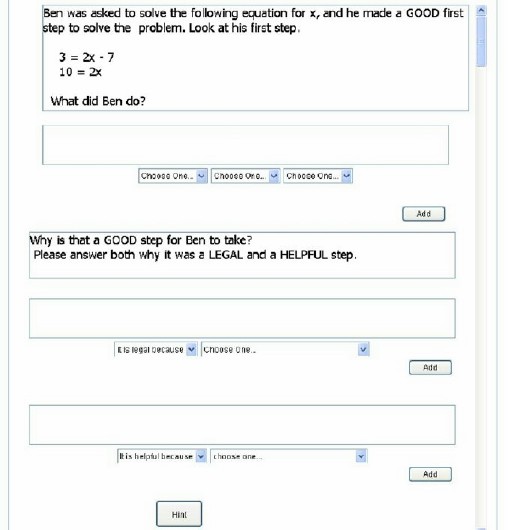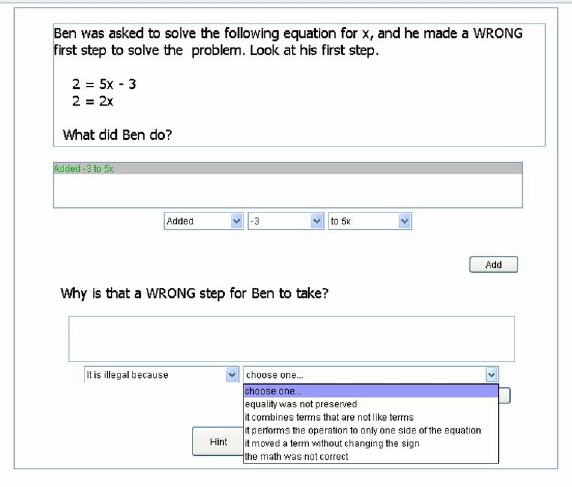Difference between revisions of "Booth"
Julie-Booth (talk | contribs) (→Glossary) |
Julie-Booth (talk | contribs) (→Background and Significance) |
||
| Line 18: | Line 18: | ||
Preliminary research in this line of studies has shown that students often have misconceptions about the importance of [[features]] in algebraic equations (e.g., negatives, equals signs, like terms) and that these misconceptions are associated with use of related incorrect [[knowledge components]] when attempting to solve algebraic equations (e.g., subtracting terms when they should be added, adding numbers to only one side of an equation, combining terms that are not like terms). This suggests that in order for [[robust learning]] to occur, we must improve students' [[conceptual]] knowledge about the features of the problem as well as their [[procedural]] knowledge. | Preliminary research in this line of studies has shown that students often have misconceptions about the importance of [[features]] in algebraic equations (e.g., negatives, equals signs, like terms) and that these misconceptions are associated with use of related incorrect [[knowledge components]] when attempting to solve algebraic equations (e.g., subtracting terms when they should be added, adding numbers to only one side of an equation, combining terms that are not like terms). This suggests that in order for [[robust learning]] to occur, we must improve students' [[conceptual]] knowledge about the features of the problem as well as their [[procedural]] knowledge. | ||
| − | Siegler’s overlapping waves theory suggests that there are two important steps that are necessary to improve knowledge (Siegler, 1996): 1) Weaken the incorrect knowledge component, and 2)Construct and strengthen correct knowledge component. Two common instructional methods (procedural practice and self-explanation of correct examples) do not highlight situations in which the knowledge components are not applicable, which will not help students weaken their overgeneralized knowledge components. [[Self-explanation]] of incorrect examples (why they’re wrong) can weaken students’ overgeneralized knowledge components by helping them to understand both that the knowledge components are incorrect and what relevant features make them incorrect (e.g., Siegler, 2002). | + | Siegler’s overlapping waves theory suggests that there are two important steps that are necessary to improve knowledge (Siegler, 1996): 1) Weaken the incorrect [[knowledge component]], and 2)Construct and strengthen correct [[knowledge component]]. Two common instructional methods (procedural practice and self-explanation of correct examples) do not highlight situations in which the [[knowledge components]] are not applicable, which will not help students weaken their overgeneralized [[knowledge components]]. [[Self-explanation]] of incorrect [[examples]] (why they’re wrong) can weaken students’ overgeneralized [[knowledge components]] by helping them to understand both that the [[knowledge components]] are incorrect and what relevant [[features]] make them incorrect (e.g., Siegler, 2002). |
===Dependent Variables=== | ===Dependent Variables=== | ||
Revision as of 16:46, 19 March 2007
Contents
Knowledge component construction vs. recall
Julie Booth, Robert Siegler, Ken Koedinger & Bethany Rittle-Johnson
Abstract
This project examines the effectiveness of corrective self-explanation, or explanation of incorrect worked examples, for improving students' knowledge components for solving algebraic equations. Students in classrooms which are using the Algebra Cognitive Tutor curriculum will complete such exercises during their otherwise typical experience solving equations with the Tutor to determine whether coordination of the two instructional methods increases robust learning; as a control, other students in the classroom will receive typical self-explanation exercises (explanation of correct worked examples) or no self-explanation exercises amid their tutor problems. Robust learning will be assessed using measures of long-term retention, transfer, and accelerated future learning.
Glossary
- Corrective Self-Explanations: Self-explanations of incorrect worked examples; explaining how and why they are incorrect
- Incorrect worked examples: Examples that include errors
Research Question
Students tend to learn overgeneralized knowledge components and apply them when attempting to solve algebra problems with incorrect features. How can we help them to learn correct knowledge components?
Background and Significance
Preliminary research in this line of studies has shown that students often have misconceptions about the importance of features in algebraic equations (e.g., negatives, equals signs, like terms) and that these misconceptions are associated with use of related incorrect knowledge components when attempting to solve algebraic equations (e.g., subtracting terms when they should be added, adding numbers to only one side of an equation, combining terms that are not like terms). This suggests that in order for robust learning to occur, we must improve students' conceptual knowledge about the features of the problem as well as their procedural knowledge.
Siegler’s overlapping waves theory suggests that there are two important steps that are necessary to improve knowledge (Siegler, 1996): 1) Weaken the incorrect knowledge component, and 2)Construct and strengthen correct knowledge component. Two common instructional methods (procedural practice and self-explanation of correct examples) do not highlight situations in which the knowledge components are not applicable, which will not help students weaken their overgeneralized knowledge components. Self-explanation of incorrect examples (why they’re wrong) can weaken students’ overgeneralized knowledge components by helping them to understand both that the knowledge components are incorrect and what relevant features make them incorrect (e.g., Siegler, 2002).
Dependent Variables
Normal posttest. Near transfer—immediate in which isomorphic problems to instruction are included for students to solve. (e.g., 3x + 10 = 20, 4x/3 + 4 = 16, 2/(-5x) = 14)
Long-term retention. Embedded assessment within instruction by the Cognitive Tutor. We will collect log data from the review portion of the next equation-solving Tutor unit to determine whether correct knowledge components are applied.
Transfer. Problems included on the posttest in two forms: 1)Procedural format with more difficult problems/problems with additional features (e.g., 2x - 7 = -5x + 9, 4/(6x) – 7 = 32). 2) Conceptual format assessing knowledge of features (e.g., State whether each of the following is the same as 3 – 4x: a. 3 + 4x b. 3 + (-4x) c. 4x – 3 d. 4x + 3)
Accelerated Future Learning. We will collect log data during tutor instruction in the next equation-solving Tutor unit when treatment is no longer in place to determine whether the slope of the learning curve is greater for students who received the corrective self-explanation treatment.
Independent Variables
Two types of self-explanation exercises:
1) Typical self-explanation (explanation of correct worked examples)
2) Corrective self-explanation (explanation of incorrect worked examples)
The design is a 2 x 2 crossing whether or not typical self-explanation is given with whether or not "corrective" self-explanation is given.
The no typical and no corrective group is the current tutor as it is, the ecological control group.
Hypothesis
Self-explanation of incorrect examples (why they’re wrong) combined with procedural practice can lead to robust learning through two processes: 1) Weaken low-feature validity knowledge components (know that they’re wrong and why they’re wrong) 2) Facilitate construction of high-feature validity knowledge components
Expected Findings
Students who receive corrective self-explanation exercises are expected to show greater robust learning of both implicit and explicit knowledge components for solving algebraic equations compared with students in other conditions. Those who receive typical self explanation exercises may show greater robust learning than those who do not get any type of self-explanation exercises (control group), but are not expected to show reduced use of incorrect knowledge components as are the groups that complete corrective self-explanation exercises.
Explanation
Students who receive corrective self-explanation exercises are expected to gain improved explicit (conceptual) knowledge about the features in problems that make certain knowledge components inappropriate. This expected to lead to greater robust learning compared with the other conditions that gain only implicit knowledge or explicit knowledge but do not have this additional knowledge about when it is appropriate to apply their knowledge components.
Corrective self-explanation is expected to affect students differently based on the amount and quality of their knowledge components prior to beginning the treatment. Students with high-feature validity knowledge components may not require corrective self-explanation for success; students with few relevant knowledge components of any sort (correct or incorrect) may not benefit from corrective self-explanation until they have acquired low-feature validity knowledge components in need of correction. This study will test the effects of the treatment in a diverse population to determine where and when corrective self-explanation may be most beneficial.
Descendents
None
Annotated Bibliography
- Presentation to the PSLC Advisory Board, Fall 2006. Link to Powerpoint slides
Further Information
Siegler, R. S. (2002). Microgenetic studies of self-explanations. In N. Granott & J. Parziale (Eds.), Microdevelopment: Transition processes in development and learning (pp. 31-58). New York: Cambridge University.

